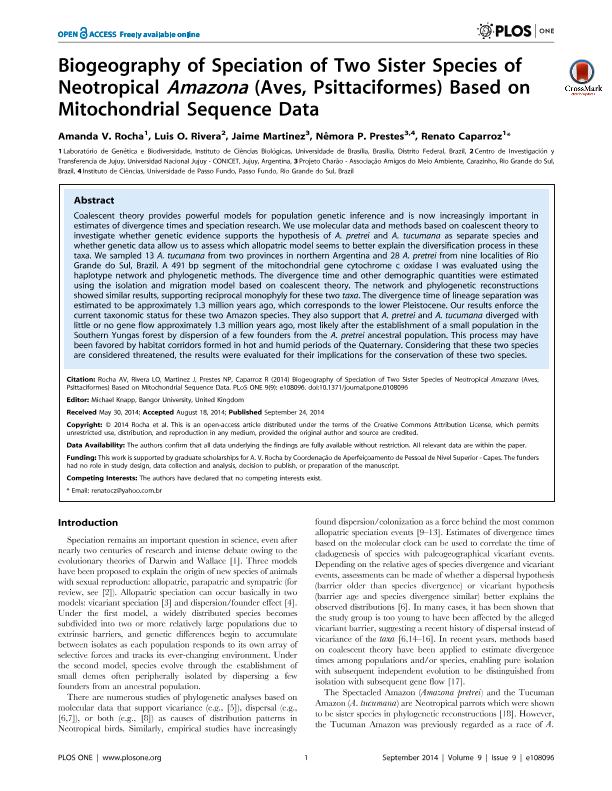Mostrar el registro sencillo del ítem
dc.contributor.author
Rocha, Amanda V.
dc.contributor.author
Rivera, Luis Osvaldo

dc.contributor.author
Martinez, Jaime
dc.contributor.author
Prestes, Nêmora P.
dc.contributor.author
Caparroz, Renato
dc.date.available
2018-01-25T18:09:35Z
dc.date.issued
2014-09
dc.identifier.citation
Rocha, Amanda V.; Rivera, Luis Osvaldo; Martinez, Jaime; Prestes, Nêmora P.; Caparroz, Renato; Biogeography of Speciation of Two Sister Species of Neotropical Amazona (Aves, Psittaciformes) Based on Mitochondrial Sequence Data; Public Library of Science; Plos One; 9; 9; 9-2014; 1-10; e108096
dc.identifier.issn
1932-6203
dc.identifier.uri
http://hdl.handle.net/11336/34612
dc.description.abstract
Coalescent theory provides powerful models for population genetic inference and is now increasingly important in estimates of divergence times and speciation research. We use molecular data and methods based on coalescent theory to investigate whether genetic evidence supports the hypothesis of A. pretrei and A. tucumana as separate species and whether genetic data allow us to assess which allopatric model seems to better explain the diversification process in these taxa. We sampled 13 A. tucumana from two provinces in northern Argentina and 28 A. pretrei from nine localities of Rio Grande do Sul, Brazil. A 491 bp segment of the mitochondrial gene cytochrome c oxidase I was evaluated using the haplotype network and phylogenetic methods. The divergence time and other demographic quantities were estimated using the isolation and migration model based on coalescent theory. The network and phylogenetic reconstructions showed similar results, supporting reciprocal monophyly for these two taxa. The divergence time of lineage separation was estimated to be approximately 1.3 million years ago, which corresponds to the lower Pleistocene. Our results enforce the current taxonomic status for these two Amazon species. They also support that A. pretrei and A. tucumana diverged with little or no gene flow approximately 1.3 million years ago, most likely after the establishment of a small population in the Southern Yungas forest by dispersion of a few founders from the A. pretrei ancestral population. This process may have been favored by habitat corridors formed in hot and humid periods of the Quaternary. Considering that these two species are considered threatened, the results were evaluated for their implications for the conservation of these two species.
dc.format
application/pdf
dc.language.iso
eng
dc.publisher
Public Library of Science

dc.rights
info:eu-repo/semantics/openAccess
dc.rights.uri
https://creativecommons.org/licenses/by/2.5/ar/
dc.subject
Parrots
dc.subject
Speciation
dc.subject
Biogeography
dc.subject
Genetic
dc.subject.classification
Otras Ciencias Biológicas

dc.subject.classification
Ciencias Biológicas

dc.subject.classification
CIENCIAS NATURALES Y EXACTAS

dc.title
Biogeography of Speciation of Two Sister Species of Neotropical Amazona (Aves, Psittaciformes) Based on Mitochondrial Sequence Data
dc.type
info:eu-repo/semantics/article
dc.type
info:ar-repo/semantics/artículo
dc.type
info:eu-repo/semantics/publishedVersion
dc.date.updated
2018-01-24T18:57:43Z
dc.journal.volume
9
dc.journal.number
9
dc.journal.pagination
1-10; e108096
dc.journal.pais
Estados Unidos

dc.journal.ciudad
San Francisco
dc.description.fil
Fil: Rocha, Amanda V.. Universidade do Brasília; Brasil
dc.description.fil
Fil: Rivera, Luis Osvaldo. Consejo Nacional de Investigaciones Científicas y Técnicas. Centro de Investigaciones y Transferencia de Jujuy. Universidad Nacional de Jujuy. Centro de Investigaciones y Transferencia de Jujuy; Argentina
dc.description.fil
Fil: Martinez, Jaime. Associação Amigos do Meio Ambiente.Projeto Charão; Brasil
dc.description.fil
Fil: Prestes, Nêmora P.. Associação Amigos do Meio Ambiente.Projeto Charão; Brasil
dc.description.fil
Fil: Caparroz, Renato. Universidade do Brasília; Brasil
dc.journal.title
Plos One

dc.relation.alternativeid
info:eu-repo/semantics/altIdentifier/doi/http://dx.doi.org/10.1371/journal.pone.0108096
dc.relation.alternativeid
info:eu-repo/semantics/altIdentifier/url/http://journals.plos.org/plosone/article?id=10.1371/journal.pone.0108096
Archivos asociados
